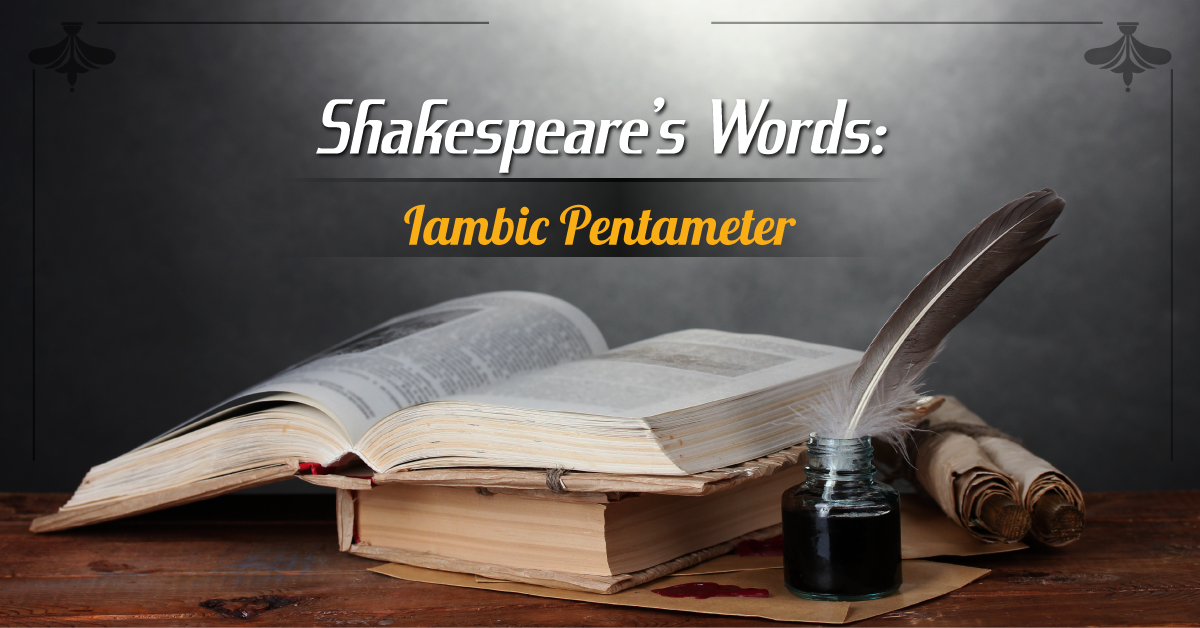The Dread Pirate Sadie: All the pirates, sword fights, and unforgettable characters - now in a competition-length version!
Shakespeare’s Words: Iambic Pentameter
A Small Group Writing Exercise
Iambic pentameter is a style of poetry, which refers to a certain number of syllables in a line and the emphasis placed on the syllables. While he did not invent it, William Shakespeare frequently used iambic pentameter in his plays and sonnets. Here are some examples that you’ll probably be familiar with. Read them out loud:
- If music be the food of love, play on. (Twelfth Night)
- O that this too too solid flesh would melt! (Hamlet)
- But, soft! what light through yonder window breaks? (Romeo and Juliet)
They flow nicely when read aloud, don’t they? So what makes them examples of iambic pentameter? Let’s quickly break down the term itself.
In poetry, two syllables together are called a foot. So in a line of poetry, the cat would be considered one foot. If you say the words, and the is unstressed and cat is stressed (i.e. the CAT), it can be represented as da DUM. An unstressed/stressed foot is known as an iamb, which is where the term iambic comes from.
In poetry, meter refers to the pattern of syllables in a line. Penta means five (think “pentagram,” a five-sided figure in math, or “Pentatonix,” a super-popular a cappella group with five members). Therefore, iambic pentameter refers to a line of poetry that has five feet of iambs (an unstressed syllable followed by a stressed syllable). So, going back to one of Shakespeare’s examples above, it would sound like:
but SOFT | what LIGHT | through YON | der WIN | dow BREAKS
da DUM | da DUM | da DUM | da DUM | da DUM
Great! Go back and read the original examples above and think about the unstressed/stressed syllables.
Some more modern sentences that use iambic pentameter might be:
- I ate my sister’s soup, and it was good.
- I can’t make rhymes when I am fast asleep.
- I wish that you and I were in Japan.
- Why do we have to go on Tuesday night?
- She likes to drink her tea with jam and bread. (Shoutout to Maria von Trapp!)
Now it’s time for students to try creating their own pieces using iambic pentameter. The following exercise has two parts – an individual warmup and a group writing portion. See below for a worksheet to guide students through the process of the exercise.
Part One
Part One consists of an iambic pentameter warmup. Students do this individually.
- Students will find and write out four examples of iambic pentameter in Shakespeare’s plays and sonnets (be sure students cite which play or sonnet the examples are from).
- Then, students will write four original lines of verse in iambic pentameter, on any topics they wish. The lines do not need to relate to each other – this is the practice portion, where they can experiment with finding the right number of syllables and making the emphasis work. Remember that an iamb is an unstressed syllable followed by a stressed syllable.
Part Two
Part Two consists of a group writing exercise.
- Have students get into groups of four. Each group will choose one topic that all four members will write about.
- Each individual group member will write four original lines of verse in iambic pentameter on that topic. The lines do not have to rhyme.
- Once each group member has created their four lines, they will work together to combine and rearrange the lines to create a monologue using all sixteen lines. Students may arrange the lines in any order that makes an interesting narrative, then adjust and edit lines as necessary.
- Once the monologue is created, students will read their monologues out loud, listening for the correct emphasis of syllables and narrative flow. Then each group will present their monologue to the class. Even though the piece is a monologue, have each group member present a portion of the piece.
Related Articles
Practical Approaches to Shakespeare in the Drama Classroom
by Julie Hartley
Shakespeare is one of the greatest resources a drama teacher can have. But teaching it can be a challenge. Practical Approaches to Shakespeare in the Drama Classroom helps drama teachers break down the Bard to make his themes, language and characters accessible to all.
Script Bundle - Shakespeare plays
A selection of 10 Shakespeare perusal scripts. Whether it's a cutting that uses the original text, a monologue or scene book, or a parody that spoofs the story, these plays offer a great window into Shakespeare's world.





